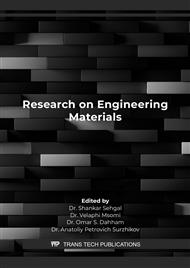[1]
Y. Cao, Y. Li, G. Zhang, K. Jermsittiparsert, N. Razmjooy, Experimental modeling of PEM fuel cells using a new improved seagull optimization algorithm, Energy Reports. 5 (2019) 1616-1625.
DOI: 10.1016/j.egyr.2019.11.013
Google Scholar
[2]
W. R. W. Daud, R. E. Rosli, E. H. Majlan, S. A. A. Hamid, R. Mohamed, T. Husaini, PEM fuel cell system control: A review, Renewable Energy. 113 (2017) 620-638.
DOI: 10.1016/j.renene.2017.06.027
Google Scholar
[3]
V. Mehta, J. S. Cooper, Review and analysis of PEM fuel cell design and manufacturing, Journal of Power Sources. 114 (2003) 32-53.
DOI: 10.1016/s0378-7753(02)00542-6
Google Scholar
[4]
S. L. Chavan, D. B. Talange, Modeling and performance evaluation of PEM fuel cell by controlling its input parameters, Energy. 138 (2017) 437-445.
DOI: 10.1016/j.energy.2017.07.070
Google Scholar
[5]
W. Saeeda, G. Warkozek, Modeling and Analysis of Renewable PEM Fuel Cell System, Energy Procedia. 74(2015) 87-101.
DOI: 10.1016/j.egypro.2015.07.527
Google Scholar
[6]
S. R. Badduri, G. N. Srinivasulu, S. S. Rao, Experimental analysis of PEM fuel cell performance using lung channel design bipolar plate, Int. J. Green Energy. 16 (2019) 1591-1601.
DOI: 10.1080/15435075.2019.1677238
Google Scholar
[7]
S. A. Ghadhban, W. H. Alawee, H. A. Dhahad, Study effects of bio-inspired flow filed design on Polymer Electrolyte Membrane fuel cell performance, Case Stud. Therm. Eng. 24 (2021) 100841.
DOI: 10.1016/j.csite.2021.100841
Google Scholar
[8]
N. Guo, M. C. Leu, U. O. Koylu, Bio-inspired flow field designs for polymer electrolyte membrane fuel cells, Int. J. Hydrogen Energy. 39 (2014) 21185-21195.
DOI: 10.1016/j.ijhydene.2014.10.069
Google Scholar
[9]
N. Guo, Bio-inspired design, fabrication and testing of bipolar plates for PEM fuel cells, Doctoral Dissertations. 1818 (2013) 1-173.
Google Scholar
[10]
V. Velisala, G. Naga, Numerical Simulation and Experimental Comparison of Single, Double and Triple Serpentine Flow Channel Configuration on Performance of a PEM Fuel Cell, Arab. J. Sci. Eng. 43 (2018) 1225-1234.
DOI: 10.1007/s13369-017-2813-7
Google Scholar
[11]
S. R. Badduri, G. N. Srinivasulu, S. S. Rao, Influence of bio-inspired flow channel designs on the performance of a PEM fuel cell, Chin. J. Chem. Eng. 28 (2020) 824-831.
DOI: 10.1016/j.cjche.2019.07.010
Google Scholar
[12]
Y. Awin, N. Dukhan, Metal-Foam Bipolar Plate for PEM Fuel Cells: Simulations and Preliminary Results, Mater. Sci. Forum. 933 (2018) 342-350.
DOI: 10.4028/www.scientific.net/msf.933.342
Google Scholar
[13]
T. A. B. Santoro, A. O. Neto, R. Chiba, E. S. M. Seo, E. G. Franco, Characterization of Proton Exchange Membrane Fuel Cell Cathode Catalysts Prepared by Alcohol-Reduction Process, Mater. Sci. Forum. 660 (2010) 94-99.
DOI: 10.4028/www.scientific.net/msf.660-661.94
Google Scholar
[14]
J. Y. Jang, C. H. Cheng, W. T. Liao, Y. X. Huang, Y. C. Tsai, Experimental and numerical study of proton exchange membrane fuel cell with spiral flow channels, Appl. Energy. 99 (2012) 67-79.
DOI: 10.1016/j.apenergy.2012.04.011
Google Scholar
[15]
H. W. Wu, A review of recent development: Transport and performance modeling of PEM fuel cells, Appl. Energy. 165 (2016) 81–106.
DOI: 10.1016/j.apenergy.2015.12.075
Google Scholar
[16]
J. P. Kloess, X. Wang, J. Liu, Z. Shi, L. Guessous, Investigation of bio-inspired flow channel designs for bipolar plates in proton exchange membrane fuel cells, J. Power Sources. 188 (2009) 132-140.
DOI: 10.1016/j.jpowsour.2008.11.123
Google Scholar
[17]
Y. Wang, C. Si, Y. Qin, X. Wang, Y. Fan, Y. Gao, Bio-inspired design of an auxiliary fishbone-shaped cathode flow field pattern for polymer electrolyte membrane fuel cells, Energy Convers. Manag. 227 (2020) 113588.
DOI: 10.1016/j.enconman.2020.113588
Google Scholar
[18]
T. Wilberforce, Z. E. Hassan, E. Ogungbemi, O. Ijaodola, F. N. Khatib, A. Durrant, J. Thompson, A. Baroutaji, A. G. Olabi, A comprehensive study of the effect of bipolar plate (BP) geometry design on the performance of proton exchange membrane (PEM) fuel cells, Renew. Sustain. Energy Rev. 111 (2019) 236-260, (2019).
DOI: 10.1016/j.rser.2019.04.081
Google Scholar
[19]
H. Heidary, M. Jafar Kermani, N. Khajeh Hosseini Dalasm, Performance analysis of PEM fuel cells cathode catalyst layer at various operating conditions, Int. J. Hydrogen Energy. 41 (2016) 22274–22284.
DOI: 10.1016/j.ijhydene.2016.08.178
Google Scholar



